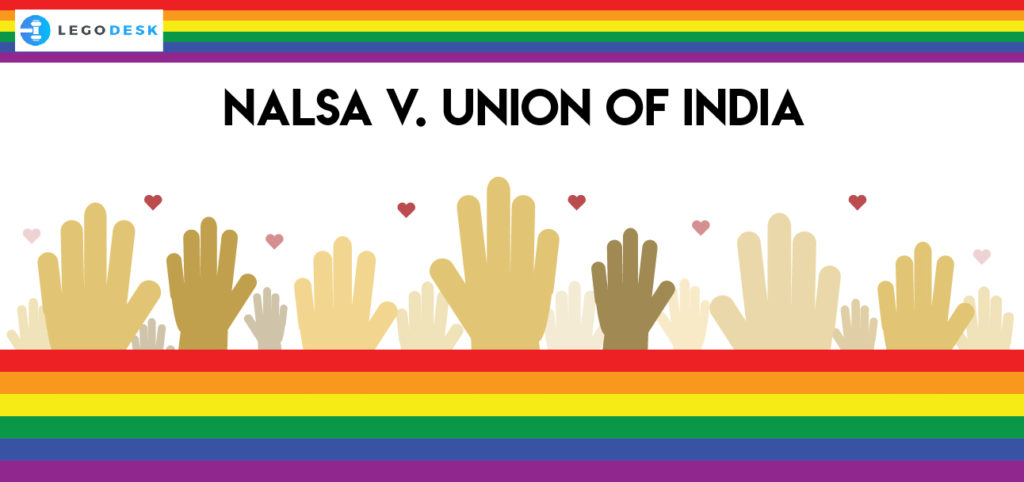NALSA v. Union of India

Nalsa v Union of India Case Study
Transgender Community was accorded a special and important status. The Hindu mythology, Vedic and Puranic literature recognized them as the third gender and bestowed them great respect. This status of the Transgender people group changed after the arrival of the Britishers or British rule in India and the Colonialists treated them in a brutal way.
As a direct consequence of the Criminal Tribes Act, 1871, there was the attrition of the status of the Transgender community as the legislature deemed the entire community as innately criminal.
The atrocities faced by Transgender community for years, from the citizens as well as the state authorities, in turn, is a violation of their many fundamental rights including those under Articles 14 and 21 of the Constitution.
Coming to 2012, National Legal Services Authority (NALSA) along with Laxmi Narayan Tripathy filed a Public Interest Litigation in Supreme Court, seeking to address the grievance and atrocities faced by the Transgender community. NALSA prayed for legal recognition of their gender and legal declaration of gender identity other than the binary gender i.e male and female.
Transgender does not fall under the “socially-accepted genders”, Transgender community is not accepted in the society and is shunned, giving them a status of untouchables. This non-recognition is a violation of their fundamental and human rights which are protected by the Constitution of India and other international Human Rights documents.
The judges while deciding the case took into consideration the international legal scenario and the recognition of the rights of the transgender community by different documents and courts.
Article 14 talks about the right to equality. It does not restrict the word ‘person’ and its application only to male or female. The Transgenders fall within the category of the word ‘person’ and are qualified for equal protection of all laws and equality before the law.
Article 15 provides for affirmative action for the advancement of minority and backward communities. The Transgender community has been denied its rights under Article 15(2) for far too long. They are outcasted from many public places like educational institutions, medical institutes, etc.
Expression of oneself according to his self-recognized gender is an aspect of personal autonomy protected under Article 21.
The judges set out the Psychological Test as against the Biological Test to distinguish the gender of an individual. At first, the test for determination of an individual’s gender, as set down by Corbett v. Corbett was his/her biological qualities during birth.
The Court held that Transgenders are entitled to affirmative action as guaranteed under Article 15(4) and also to the reservation in the matter of appointment.
The court further emphasized on the need for legal recognition of third or transgender identity and concluded that they belong to a distinct socio-religious and cultural group and must be given the status of a “third gender”, apart from the binary gender i.e male and female.
Justice K.S. Radhakrishnan, speaking on behalf of the Court, concluded the judgment by holding that discrimination on the basis of sexual orientation or gender identity includes any discrimination, exclusion, restriction or inclination, which has the impact of invalidating or transposing equality by the law or the equal protection of laws ensured under our Constitution.
Guidelines are given by the NALSA judgment
- Hijras, Eunuchs are to be treated as “third gender”.
- Transgenders have the right to decide their self-identified gender.
- Take steps to treat Transgenders as socially and educationally backward classes of citizens in cases of admission in educational institutions and for public appointments.
- Governments to operate separate HIV Zero-Surveillance Centres.
- Governments to seriously address the problems faced by Transgenders.
- Provision for separate public toilets and appropriate medical care in hospitals.
- Governments to frame various social welfare schemes for the betterment of Transgender.
- Governments to create public awareness so that Transgenders will not be treated as untouchables.
- Take measures to regain the respect and place of Transgender in the society which they once enjoyed.
The judgment does not provide a long-term and extensive solution to the problems faced by transgenders. It merely gives a cursory glance at these problems
- Present Situation
The taboo still persists in society. The transgender community is still and are and are treated as outcasts.
However, society is progressing. The transgender community is recognized as a third gender not only legally but also in society. They are securing jobs in the government sector, provided a proper education and given the rights that they should have been given long back.
There also remains a need for the sensitization of the masses regarding the transgender community, descriptive and comprehensive guidelines and special provisions of counselling, significant medical attention, separate public toilets and detention facilities to be provided to the third gender.
Try our Debt Resolution solutions today Request a Demo